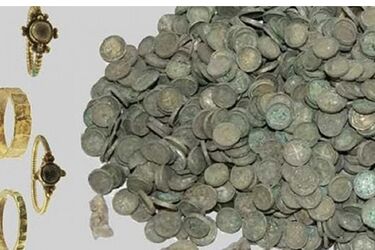A 950-year-old ring of Yaroslav the Wise's great-granddaughter found in Poland

A group of archaeologists from the Institute of Archaeology and Ethnology of the Polish Academy of Sciences, who were researching ancient settlements near the village of Sluszków, found a large number of ancient artifacts dating back 900 years. Among the items found were ceramic vessels that contained denarii, a total of 6500 silver coins in linen bags, as well as silver bars and 4 rings, two of which were wedding rings.
This was reported by UaInfo.
According to the archaeologists, the rings probably belonged to a Russian princess named Maria, who was a relative of Sbyslava Sviatopolkivna, the daughter of Grand Prince Sviatopolk of Kyiv. The larger ring had a conical shape, while the smaller ring was made like a rod with holes punched through it. Archaeologist Dariusz Wychulkowski noted that the rings were decorated with precious stones that were polished in a semicircle and decorated with gold granules.
One of the rings had an inscription saying, "Lord, help your servant Mary," which further confirmed that it belonged to the princess. Scholars say that Maria was probably the daughter of Oleh Sviatoslavych, Prince of Volyn and grandson of Yaroslav the Wise.
According to the Primary Chronicle, Sbyslava, Sviatopolk's daughter, was sent to Poland in 1102 to marry Bolesław III Krzywousty to establish an alliance between the families of the Kyiv and Hungarian princes. Her mother was probably from the Czech Přemyslovych dynasty. Sbyslava's wedding took place in the winter of 1102/1103.
Read also: An immigrant from Mariupol accidentally found a 4000-year-old treasure in the Ternopil region
Professor Adrian Jusupović from the Institute of History of the Polish Academy of Sciences in Warsaw suggested that the treasure found with the rings could be related to a dowry specifically intended for Maria, which may have been hidden near Slushkiv. This may be related to the capture of Prince Volodymyr of Przemysl by Petro Włostowicz. According to the researchers, the treasure may have been hidden in 1145/1146 during Petro Włostowicz's escape from Poland.
All of these discoveries may reveal new aspects of the life and customs of the rulers and population of the time.
As a reminder, a 1400-year-old tombstone of St. Mary was found in Israel.
If you want to get the latest news about the war and events in Ukraine, subscribe to our Telegram channel!
